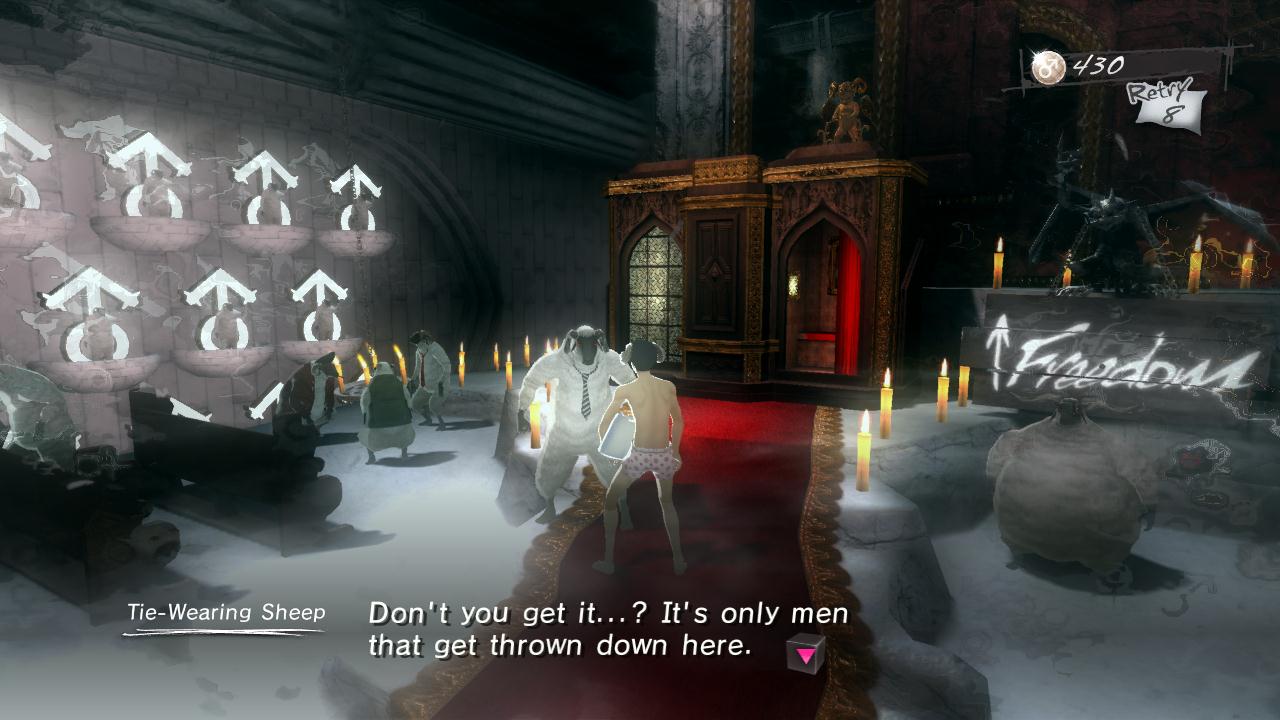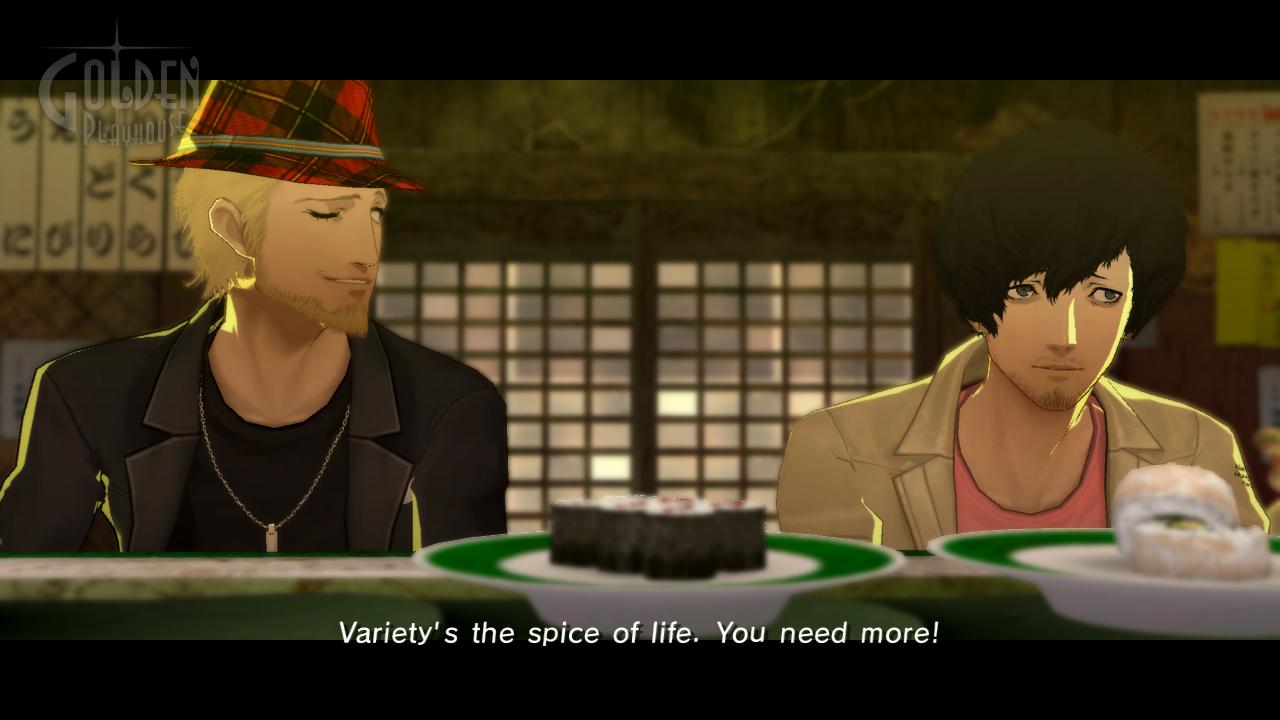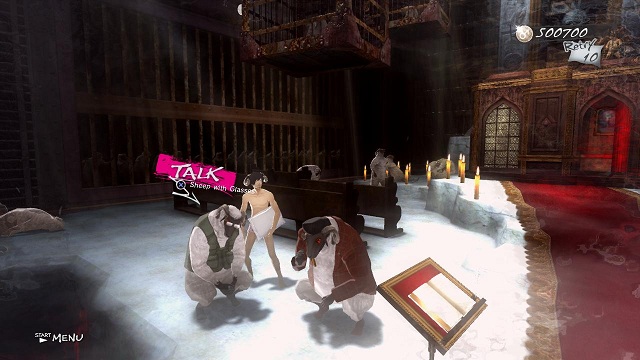Catherine Review
 Game: Catherine
Game: Catherine
Developer: Atlus
Publisher: Deep Silver
Available on: Xbox 360, PlayStation 3 (Reviewed on Xbox 360)
Counting sheep has long been associated with sleeping. So in a game where nightmares and the sleep state is the focus, it shouldn’t be surprising that it features sheep, right? What about talking sheep? And sheep with sunglasses or a pompadour haircut? And our protagonist is seen with his own ram horns, running around in nothing but a pair of boxer shorts.
Atlus are probably best known for their Shin Megami Tensei RPG titles, which include the popular Persona series. Whilst we wait for news on Persona 5, the first current-gen Shin Megami Tensei game, the development team have put out the incredibly strange puzzle-horror-adventure game, Catherine. The game blends RPG elements with platform-style puzzling and somewhat of a dating sim. With so many different elements rolled into one, how does this strange combination fit together?
STORY: It has got to be said that the story really is central to the game. Everything in the title works towards pushing forward the story of representing the state of mind of our protagonist. We play as Vincent, a thirty-something with a long-term girlfriend, Katherine. After Katherine suggests the notion of marriage, it sets in motion a chain of events that plunges Vincent into a spiral of confusion, whereupon he meets a new girl, named Catherine, who pursues Vincent almost obsessively. Alongside this dilemma, there is a rumour around town that many men have been cursed to suffer horrible nightmares, with many seemingly dying both in their dreams and real-life. It is said that the dreams only affect cheaters. In the dreams, men appear as Sheep, all trying to scale seemingly impossible mountains of blocks, to escape certain doom.

So when Vincent begins to experience the very same bizarre nightmares, and then wake up every morning beside Catherine, with no memory of what happened the night before, he becomes increasingly concerned that he too has been cursed, and is losing his mind. Through working our way through the puzzle levels and interacting with other NPC’s during the RPG sections, we learn more of the truth behind the curse, and try to aid other unlucky men who are trapped in the same repeating nightmare.
The story is as weird as it sounds, but a lot of care and attention is given to developing it well and in keeping the gamer interested in what will happen next. As the story goes on, there are a lot of twists and turns, and the title is full of surprises. There are many decisions and conversation options that the player can choose as they go along, each one affecting your relationship with different characters and your good/evil state of mind balance. These in turn will change the way that characters react to Vincent, and how Vincent behaves in certain situations. The fact that there are eight different endings shows you just how much the tale can differ from one person to the next. This does mean you can choose how you want to play the title; and there is quite some replay-ability in going back to try out the various options.
GRAPHICS: The art style is fantastic and immediately eye-catching. The developers seamlessly blend their 3D character models with hand-drawn Anime cutscenes, created by the same studio who produced the Animatrix. The polygonal characters that have been created for the in-engine cutscenes and RPG-style sections are very impressive, and could be straight out of an Anime themselves. The art style will be instantly familiar to fans of the Persona series, and many have speculated that Catherine was a test of the engine before Persona 5 went into development. Either way, all of the different gameplay elements mesh together well, with the nightmare sequences obviously taking on a more abstract style, what with humanoid sheep and killer babies roaming around the mountains and pyramids made up of blocks that you must navigate.
SOUND: Being a story-driven title, there is bound to be a lot of speech or narration, and Catherine certainly delivers. Being translated from Japanese, and being such strange subject matter, one might not have high hopes for the dubbing, but thankfully the voice-acting stands out as high quality, with many great characters who have extremely expressive and unique voices. None of them grate, or seem to let the side down, and each voice seems to match the corresponding character perfectly. Vincent sounds nervous and unsure, the long-suffering Katherine has an impatient, disappointed voice, and the voice that draws you ever onward in your nightmares is suitably creepy. The casting director hit the nail on the head with the cast members here.
Along with voice-over work, the music is also of a high quality. Very Japanese, but the tunes are likeable without ever becoming irritating, even when you have to re-try various stages, the music often repeating . The same can’t be said for some of the sound effects. For instance, every time you pull out a block, and it connects with the edge of another, the game will say “edge”. Similarly, every time you press the back button to rewind and erroneous move, the game says “back”. Understandably, both of these actions are ones that you will perform on hundreds of occasions, just in the space of an hour of playing the puzzle stages. This means these sounds get really irritating, and you question why the design team thought it was a good idea to say it every time. This aside, the other sound effects are good, and help add to the creepy, supernatural atmosphere.
GAMEPLAY: At its core, Catherine appears to be a somewhat simple puzzle title. Something of a mixture between classic puzzle games Tetris and Q-Bert, the game is all about hopping from block to block, all the while trying to slot the blocks together in a certain way, one that will ultimately lead to a goal at the top. As you try to scale the wall, blocks will slowly fall away from below, meaning Vincent must race against time, or fall into the abyss below. The stacks of blocks must be moved in order to form steps and pathways, so that the player can progress higher. Blocks can be pushed and pulled, and the player can dangle from the side and shimmy around the edge of blocks, in order to find a successful route. Depending how quickly and ably you complete a stage, you may gain a bronze, silver or gold trophy, with gold unlocking the level for you to play in the separate Babel challenge mode.

Making things all the more complex are speciality blocks. These include ice ones, that slide when pushed, and also cause players to slip off the edge of the game-world if they aren’t careful. There are also bomb blocks, that will weaken the surrounding ones, causing them to crumble and fall, or even monster blocks, that have faces and will slide out of the way in an unhelpful manner as you try to climb on them. There are more block types, and all of these must be managed and taken into account as you try to reach the goal. There are power-ups to help along the way though, such as pillows to pick up, which act as re-try tokens if you fail. You can also get power-ups that will let you place a block wherever you wish, or one that might turn all speciality blocks on-screen into normal ones. These can be invaluable when you find yourself in a tight spot with nowhere to run. The final main tool at your disposal is the back button. This will rewind your previous moves, and can be used several times to undo your last few actions. This is necessary if you work yourself into a corner and need to try again, without re-starting the whole level.
Other sheep will also be trying to climb the stages, and Vincent will have to engage in shoving matches with them in order to avoid them getting in his way and slowing him down. But his main opponents are the boss stages, which appear between every three or four regular ones. These play out like a boss chase, with a big enemy following you up the wall, destroying it as they go. The boss will unleash attacks that try to slow you down, such as throwing projectiles or slashing at you with weapons, and you must avoid these at all costs to escape instant death. You will need to make use of the pillow pick-ups and the checkpoints scattered through the stage in order to pass the boss battles, as these are very frantic and can take a bit of trial and error. Whereas on a normal stage you might have a bit of time to survey the area and plan your ascent, the boss stages are much more of a twitch and reflex affair; making it a welcome change of pace.
Outside of the puzzle game, the action mainly takes place in the Stray Sheep bar, a hangout which Vincent and his friends frequent. Here you can talk to NPC’s, which will both flesh out the story and determine the fate of your fellow nightmare-sufferers. Help out the other victims and give them advice in the real world, and they will more likely succeed in the nightmare world. As Vincent talks with the locals, he can order a variety of drinks (that actually speed you up in the dream world), play on an arcade machine called Rapunzel, found in the bar (which plays like a retro version of the main puzzle mode, with slightly different rules), or make use of the email found on his phone. This is where you can save your progress, replay previous levels or correspond with both Catherine and Katherine. Your message here can also greatly shape the outcome of your relationships. This bar area makes the game feel far more like an RPG than just a puzzle title, and adds some depth to what could have been a pretty shallow experience.

MULTIPLAYER: After you have completed the main game, and unlocked Colosseum mode, as well the Babel mode (which is a solo or team-based challenge mode, acting like a time attack) levels, you will have the choice of playing these with friends. Colosseum is exclusively head-to-head races for two players. You control either the red or blue sheep, and both players race to reach the goal before the other. Matches are best of three, and a victory is scored by reaching the exit door first, or by being the last man standing if the other sheep falls or dies. Of course, as with any good head-to-head title, dirty tactics and fighting come into play, with players shoving each other, pushing blocks on top of one another and trying to sabotage the route so the other sheep cannot follow you. These can be quite competitive, and as the courses in this mode are all shortened versions of the full version, the action remains fast and furious.
On the other hand, Babel sees the two of you working together to try and get both Vincent and Katherine successfully to the end of the stage, as quickly as you can. These scores can then be compared to online Leaderboards, to see how well your team matches up to competitors from around the world. The fact that you have to get two players up the mountain does mean you have to re-think your moves, as many tactics in single-player simply won’t allow for two players to perform the same action. Without intelligent moves and thinking ahead, the two of you will soon be stuck and have to re-start. These two Multiplayer modes may not be very deep, but they do add a little extra life to the title, and offer a different experience from the core game.
LONGEVITY: In itself, the story mode is likely to take you around fifteen to twenty hours of play, being a fairly weighty adventure. The addition of the two-player modes and the fact that there are eight different outcomes to the story means that there is a lot of incentive to return to the game later. The Babel challenge mode will take a long time to master, both in single and multiplayer, and in order to unlock all Babel levels the player must attain gold trophies in each story puzzle. So to experience every level in each mode, you will have to re-play the main story and master each puzzle stage. And on top of all of that, add in the Rapunzel arcade game-within-a-game, with its 128 stages of puzzling action, and the game is hiding even more layers of content to conquer. To finish every aspect of the game, you could plunge many hours into this title.
VERDICT: Catherine is unlike any other game you are likely to play on any system. It is a unique breed, how many games could claim they are both a relationship simulator and a twisted nightmare puzzle game? It is difficult to do justice to the game in words, and it really is something that needs to be experienced in order to really “get”.
But what is clear is that the game oozes style from every pore, whether it be audio, visuals or the deft combination of gaming styles. It won’t be to everyone’s taste, as the story is bizarre to say the least, the puzzle elements are perhaps too twitchy for RPG purists and the RPG elements may be a bit slow for those looking for action, but what the game does do is create a happy balance between the modes, where the title straddles genres with confidence. An acquired taste perhaps, but whilst the setting is nightmarish, it plays like a dream.







